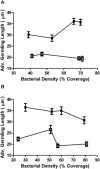Interference with the germination and growth of Ulva zoospores by quorum-sensing molecules from Ulva-associated epiphytic bacteria
- PMID: 23879807
- PMCID: PMC4304359
- DOI: 10.1111/1462-2920.12203
Interference with the germination and growth of Ulva zoospores by quorum-sensing molecules from Ulva-associated epiphytic bacteria
Abstract
Ulva zoospores preferentially settle on N-acylhomoserine lactone (AHL) producing marine bacterial biofilms. To investigate whether AHL signal molecules also affect the success and rate of zoospore germination in addition to zoospore attraction, the epiphytic bacteria associated with mature Ulva linza were characterized and bacterial isolates representative of this community tested for the ability to produce AHLs. Two of these AHL-producing isolates, Sulfitobacter spp. 376 and Shewanella spp. 79, were transformed with plasmids expressing the Bacillus spp. AHL lactonase gene aiiA to generate AHL-deficient variants. The germination and growth of U. linza zoospores was studied in the presence of these AHL-deficient strains and their AHL-producing counterparts. This revealed that the AHLs produced by Sulfitobacter spp. and Shewanella spp. or the bacterial products they regulate have a negative impact on both zoospore germination and the early growth of the Ulva germling. Further experiments with Escherichia coli biofilms expressing recombinant AHL synthases and synthetic AHLs provide data to demonstrate that zoospores germinated and grown in the absence of AHLs were significantly longer than those germinated in the presence of AHLs. These results reveal an additional role for AHLs per se in the interactive relationships between marine bacteria and Ulva zoospores.
© 2013 Society for Applied Microbiology and John Wiley & Sons Ltd.
Figures

- A
Average germling length of zoospores exposed to biofilms of AHL-expressing Shewanella sp. 79 pBBRIMCS (□) and non-AHL expressing Shewanella sp. 79 pMT01 (□) at 48 h incubation.
- B
Average germling length of zoospores exposed to biofilms of AHL expressing Sulfitobacter sp. 376 pBBRIMCS (□) and non-AHL expressing Sulfitobacter sp. 376 pMT01 (□) at 48 incubation. Error bars represent 95% confidence intervals.


Similar articles
-
Turnover of quorum sensing signal molecules modulates cross-kingdom signalling.Environ Microbiol. 2009 Jul;11(7):1792-802. doi: 10.1111/j.1462-2920.2009.01904.x. Epub 2009 Mar 31. Environ Microbiol. 2009. PMID: 19508552
-
Disruption of quorum sensing in seawater abolishes attraction of zoospores of the green alga Ulva to bacterial biofilms.Environ Microbiol. 2005 Feb;7(2):229-40. doi: 10.1111/j.1462-2920.2004.00706.x. Environ Microbiol. 2005. PMID: 15658990
-
Cross-kingdom signalling: exploitation of bacterial quorum sensing molecules by the green seaweed Ulva.Philos Trans R Soc Lond B Biol Sci. 2007 Jul 29;362(1483):1223--33. doi: 10.1098/rstb.2007.2047. Philos Trans R Soc Lond B Biol Sci. 2007. PMID: 17360272 Free PMC article. Review.
-
Acyl-homoserine lactones modulate the settlement rate of zoospores of the marine alga Ulva intestinalis via a novel chemokinetic mechanism.Plant Cell Environ. 2006 Apr;29(4):608-18. doi: 10.1111/j.1365-3040.2005.01440.x. Plant Cell Environ. 2006. PMID: 17080611
-
Quenching of acyl-homoserine lactone-dependent quorum sensing by enzymatic disruption of signal molecules.Acta Biochim Pol. 2009;56(1):1-16. Epub 2009 Mar 17. Acta Biochim Pol. 2009. PMID: 19287806 Review.
Cited by
-
Cross-kingdom signalling regulates spore germination in the moss Physcomitrella patens.Sci Rep. 2020 Feb 13;10(1):2614. doi: 10.1038/s41598-020-59467-5. Sci Rep. 2020. PMID: 32054953 Free PMC article.
-
Modulation of Host Biology by Pseudomonas aeruginosa Quorum Sensing Signal Molecules: Messengers or Traitors.Front Microbiol. 2015 Nov 9;6:1226. doi: 10.3389/fmicb.2015.01226. eCollection 2015. Front Microbiol. 2015. PMID: 26617576 Free PMC article. Review.
-
First report of Planomicrobium okeanokoites associated with Himantothallus grandifolius (Desmarestiales, Phaeophyta) from Southern Hemisphere.PLoS One. 2023 Apr 14;18(4):e0282516. doi: 10.1371/journal.pone.0282516. eCollection 2023. PLoS One. 2023. PMID: 37058520 Free PMC article.
-
A review of quorum-sensing and its role in mediating interkingdom interactions in the ocean.Commun Biol. 2025 Feb 5;8(1):179. doi: 10.1038/s42003-025-07608-9. Commun Biol. 2025. PMID: 39905218 Free PMC article. Review.
-
The effect of the algal microbiome on industrial production of microalgae.Microb Biotechnol. 2018 Sep;11(5):806-818. doi: 10.1111/1751-7915.13296. Epub 2018 Jul 5. Microb Biotechnol. 2018. PMID: 29978601 Free PMC article. Review.
References
-
- Bradley PM. Plant hormones do have a role in controlling growth and development of algae. J Phycol. 1991;27:317–321.
-
- Callow JA, Stanley MS, Wetherbee R. Callow ME. Cellular and molecular approaches to understanding primary adhesion in Enteromorpha: an overview. Biofouling. 2000a;16:141–150.
-
- Callow ME. Callow JA. Substratum location and zoospore behaviour in the fouling alga Enteromorpha. Biofouling. 2000;15:49–56. - PubMed
Publication types
MeSH terms
Substances
LinkOut - more resources
Full Text Sources
Other Literature Sources
Molecular Biology Databases
Miscellaneous

